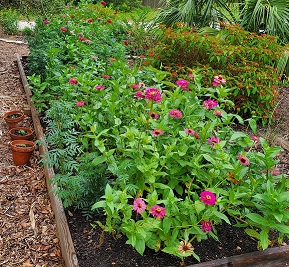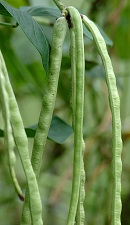Written By Leslie Munroe and Yvonne Florian.
Gardening once again became America’s pastime this past year due to “stay at home” and “social distancing” mandates. Many people took up vegetable gardening to pass the time in a healthful, nurturing manner. If you are new to the vegetable gardening process you may be surprised to learn that most seasoned vegetable gardeners in south Florida grow very few edibles during the summer.

The more experienced among Florida gardeners use this time for cover cropping and planning for the next season.
Preparing the Bed for Summer
By the end of May, Florida’s veteran-gardeners know to remove all of last season’s remaining vegetable plants from their growing spaces. But you should not just leave those spaces empty. That would open up prime real estate for opportunistic weeds to get a strong foot hold, stealing valuable nutrients from the very soil we try so hard to build up.
Instead, to improve their vegetable plots, Florida gardeners should chose one of two options for summer:

- Cover Crop
- Solarization
Cover cropping is the Florida vegetable gardener’s best friend in summer. Cover Cropping is using plants to occupy your soil, literally covering the space until you are ready to use it for another crop. This leaves no room for weeds and could possibly enrich the soil in the process, depending upon which cover crops you choose. You may still need to water your cover plants, but if you chose well, they should tolerate the summer heat with little supplemental irrigation.
How to Cover Crop Like a Professional

Last summer, I cover cropped my raised garden beds with members of the pea family. Deciding to rotate even my cover crops from year to year, I am cover cropping with flowering plants this year using zinnia and marigold as cover. There is evidence that cover cropping with certain varieties of marigolds may be helpful in the fight against root-knot-nematodes. Leaving the marigold roots in the soil could repel the tiny beasties. Also, using legume crops can help pull nitrogen from the air and “fix” it for use in soil for subsequent crops. Four cover crop choices from different plant families include:
- legumes/fabaceae- bean family such as cow peas, crimson clover,
- flowering brassicas- mustards, radish, turnip,
- asteraceae- sunflowers, zinnias, calendula, echinacea, etc.
- buckwheat- Polygonaceae- there’s even a pink flowering variety.
Sun Powered Solarization
On the other hand, solarization is generally used during our hottest season to kill off unwanted weed seeds, harmful insect larvae, and nematodes. This process uses a heavy sheet of clear plastic sheeting installed directly over the soil in the garden plot. Magnified under the clear plastic, the power of the sun heats the soil, raising soil temperatures. Once temperatures reach a certain degree nematodes move out, weed seeds may die, and pupating garden pests can expire under the blaze. It is not a “cure-all” for nematode issues but it can improve your chances of a good harvest for a season or two.
A Garden Example- Gifford Youth Achievement Center Community Garden
This summer, the newly vacant soil at the Gifford Community and Student Garden will be covered with a mixture of zinnia, marigold, and sunflower seeds. The flowers will provide a colorful view and cover so weeds will not encroach. They will also provide food and shelter for various beneficial insects.
Planning
With your garden space covered for the summer, what will you do with all that free time? Just like northern winters, our summers are not hospitable for working and growing in the garden. It is the perfect time to plan and prepare for our busy Fall/Winter season coming up. Get your compost turned and ready for next season. Sharpen and oil all your garden tools and eradicate rust on blades of shovels, hoes, clippers and shears.
The end of summer is when Florida gardeners will start most of our edible cultivation of beefsteak tomatoes, beans, squash, peppers and greens. For now, store any unused seeds in an airtight container in the refrigerator and order any new seeds you may need for the August/September planting. It may be helpful to keep a notebook or Garden Journal. This gives you a place to write down and check on the triumphs and tragedies of gardens past:

- Which plants did well?
- Which vegetable varieties were liked the best?
- Crop rotation: which plant family did I plant where the last two seasons?
- With whom can I swap seeds?
- Which seed company had the best deals, the best seed, customer service, and free shipping?
- What new vegetable would I like to try next season?
If you would like to learn more about cover cropping your vegetable garden beds, crop rotation, “what are nematodes?”, or solarization, please contact your Indian River County Master Gardener Plant Help Desk at (772) 226-4330 extension 1. You could also send the Master Gardeners an email with detailed gardening questions, photos of plant problems, or photos of plants or insects for identification to ircmg1@gmail.com. These questions are usually answered within a week now that the Master Gardeners are once again back at the desk.
To read more about Cover Crops and Cover cropping, please see the University of Florida’s Institute of Food and Agricultural Sciences Electronic Data Information Source topic page on cover crops at Ask IFAS – Powered by EDIS (ufl.edu).
If you would like a Florida Gardening Calendar chart showing what vegetable plants do best during which season in Central and South Florida, please read the UF/IFAS EDIS publication, “Florida Vegetable Gardening Guide”, there is a handy reference chart at the end with specific information on ideal planting times for most of the common vegetable garden plants.
To learn about solarizing you garden beds to reduce pests, UF/IFAS has two EDIS publications entitled “Introduction to Soil Solarization” and “Solarization for Pest Management in Florida”.
For further reading on cover crops to manage root-knot nematodes, please see the UF/IFAS EDIS publication entitled, “Cover Crops for Managing Root-Knot Nematodes“.
To learn more about composting, building up poor soils with organic soil amendments, recycled organic materials to improve your soil, and more, please visit the UF/IFAS Compost topic page here.
 2
2
